There are thousand snake species in the world. They come in a wide range of colors from browns and blacks to those with blues, reds, and pinks.
If you think you saw a pink snake or you want to find out more about what snakes may be pink, continue reading to find out more.
Table of Contents
Are Pink Snakes Venomous?
All snakes have some degree of venom, which is used to subdue their prey. Whether they are hunting a small slug or a small bird. Not all pink snakes are venomous to humans. Those that are known to be venomous to humans, causing unwelcome side effects are the rattlesnakes listed above.
Types of Pink Snakes
The 20 types of pink snakes you may encounter in the world include:
1. Corn Snake

Scientific name: Pantherophis guttatus.
Common name: corn snake, American corn snake.
The corn snake is a rat snake species from North America, which uses constriction to subdue small prey. They are common in central and southeastern United States, looking similar to the dangerous and venomous copperhead. Corn snakes are beneficial as they help control rodent populations.
An adult corn snake can grow to 182cm in length with an eight-year lifespan in the wild, but they are known to live up to twenty-three years in captivity. They are brighter than copperheads with a slender build.
They usually range in color from a pink or orange to a brown/yellow color with black-edged red or pink patches down the center of the back. The belly has a checkerboard pattern in black and white.
2. Western Blind Snake
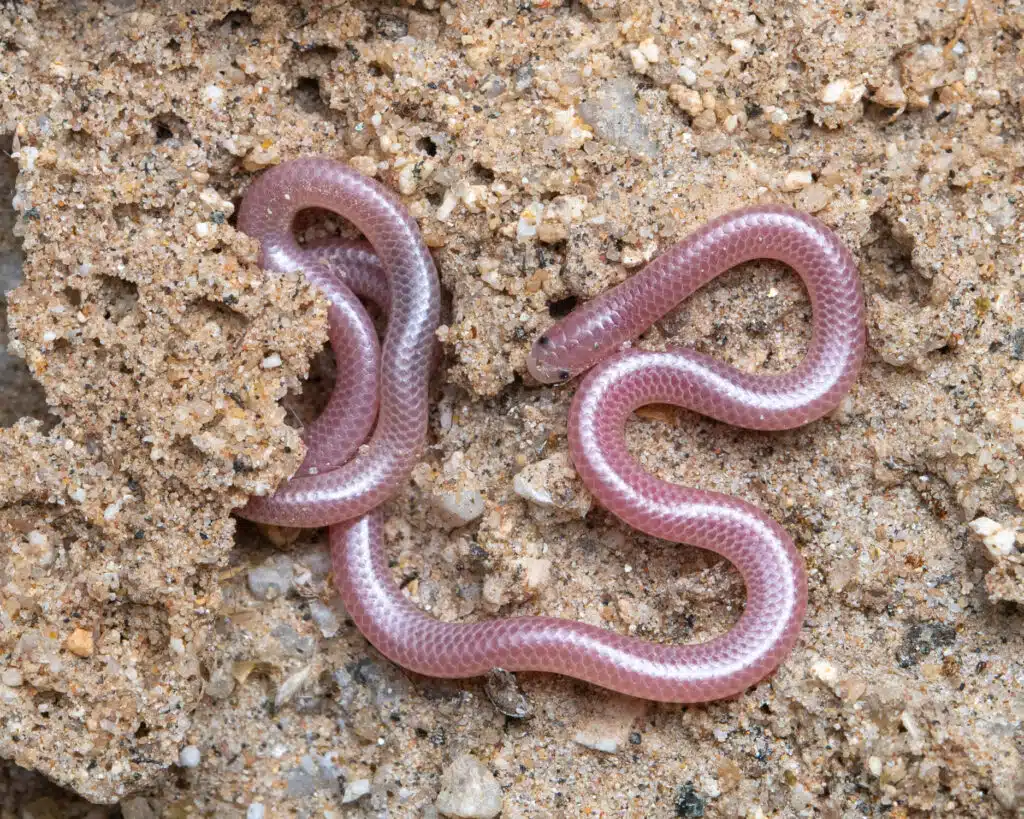
Scientific name: Rena humilis.
Common name: western blind snake, western slender blind snake, western threadsnake.
Western blink snakes belong to the Leptotyphlopidae family and are endemic to the southwestern United States and Northern Mexico. They resemble long earthworms, living in underground burrows.
They come in a range of colors from pink or purple to silver brown. They are shiny, cylindrical, and very worm-like. They have a thick skull which enables them to burrow effectively, as it uses its tail to help it with leverage.
These snakes grow to around 30cm, including their tails. They are very rarely encountered, living underground. They are known to burrow up to twenty meters below the surface.
They raid ant and termite nests, feeding on insects, larvae, and insect eggs.
3. Western Coachwhip
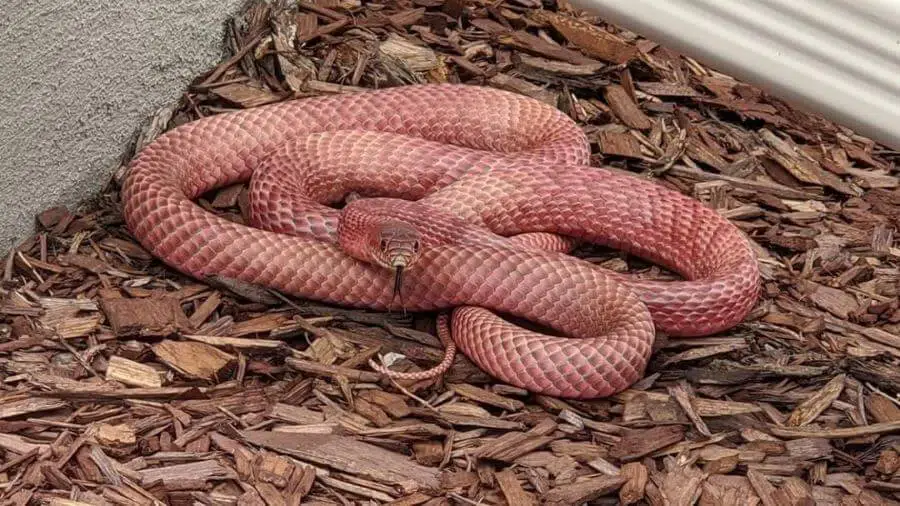
Scientific name: Masticophis flagellum testaceus.
Common name: western coachwhip.
The Western coachwhip is a non-venomous snake, often called a whip snake. They are endemic to Mexico and the United States.
These thin-bodied snakes have small heads with large eyes. They vary in color, reflecting their natural habitat, helping them camouflage into their surroundings. They are usually a light brown with dark brown flecks, but pink varieties have been seen in Western Texas.
An adult can grow to 183cm in total length, including the tail. They are common in open areas with sandy soil, including old fields, open pine forests, and prairies. They are also common in coastal dunes.
4. Aruba Rattlesnake
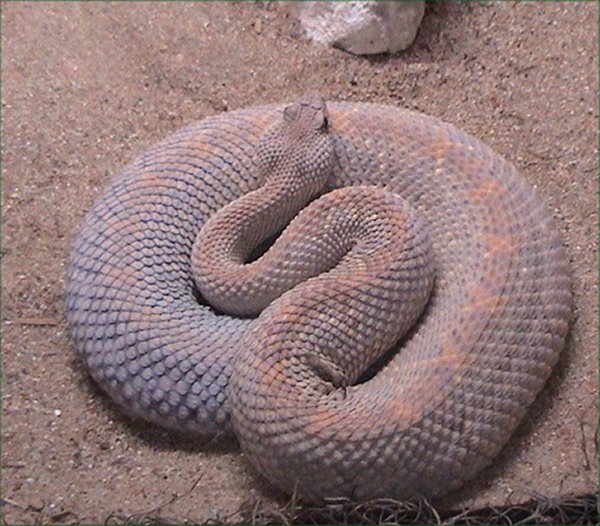
Scientific name: Crotalus unicolor.
Common name: Aruba rattlesnake, Aruba island rattlesnake.
The Aruba rattlesnakes is a venomous pit viper, only found on Aruba Island in the Caribbean. These are moderately sized snakes that can grow to 90cm as adults. Their coloration ranges from a tan or light brown to pink, usually reflecting the color of the soil in their habitat.
They have dark brown diamond markings, though the markings can range from white to slate and brown to apricot. Some have a barely visible pattern, others may have a slight pattern, while others may be vivid.
They are only encountered in the desert habitats and thorn scrub on the south-eastern half of Aruba Island, just off the coast of Venezuela.
5. West Kimberley Blind Snake
Scientific name: Anilios zonula.
Common name: West Kimberley blind snake.
The west Kimberley blind snake is endemic to Australia with a very slender appearance. They can grow to 19cm as adults and are a pale to purple-pink color.
They are encountered in the Western Kimberley region, only being recorded on Augustus and Storr Islands. The specimens were found under sandstone rocks.
6. Worm Snakes
Scientific name: genus Carphophis.
Common name: worm snakes.
Worm snakes are small snakes endemic to the United States. They grow to 35cm in total length and are dark brown on their upper side with a light pink or orange belly.
They are often mistaken for earth snakes and brown snakes. They have small eyes on a narrow head with a sharp tip to their tail. They are completely harmless to humans.
These snakes spend their life buried in rocky and loose soil or under leaf litter. They are abundant in forest areas but are seldom seen due to their secretive nature.
7. Slender Blind Snakes

Scientific name: genus Leptotyphlops.
Common name: slender blind snakes, threadsnakes.
Slender blind snakes are non-venomous snakes that are slender in build. They are endemic and found throughout Africa. They look similar to earthworms but are shiny.
Their coloration is usually pink or brown color with scales, giving them a segmented appearance. They are burrowing snakes, spending their time in soil, only coming out when it rains and their burrows get flooded.
8. Pink Rattlesnake
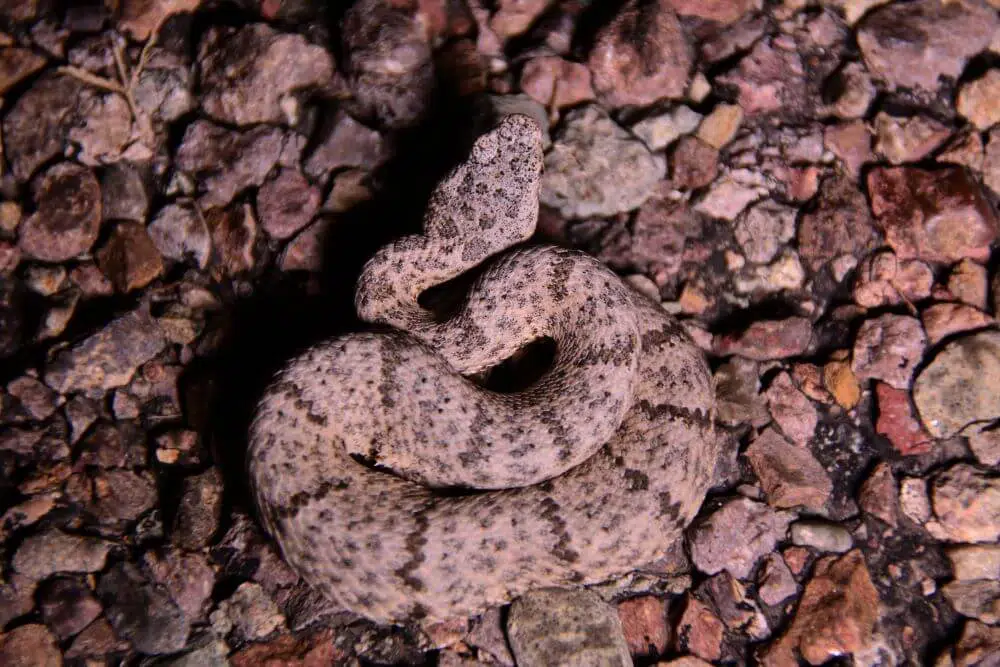
Scientific name: Crotalus lepidus.
Common name: blue rattlesnake, eastern rock rattlesnake, green rattlesnake, little green rattlesnake, pink rattlesnake, rock rattlesnake, Texas rock rattlesnake, and white rattlesnake.
The pink rattlesnake is a venomous pit viper found in north-central Mexico and the southwestern United States. They are a small species, growing to 81cm in length.
They are heavy-bodied for their small size with large round heads and vertical pupils. The tail has a rattle and a new segment of the tail is added with each molt. Their coloration varies based on the rock color of their natural environment.
Snakes found near limestone, tend to be light gray, while those at higher altitudes are darker. Those from the Davis Mountains region are more pink in color with dark specks and no distinct banding.
They are not an aggressive species and are popular with experienced exotic pet owners. They camouflage themselves and will not strike or rattle their tail unless they are harassed. They live in rocky outcrops and are nocturnal.
The most common cause of pink rattlesnake bites is hikers that accidentally stand on one when hiking. Biting is the snake’s immediate defense reaction to protect itself.
9. Eyelash Viper
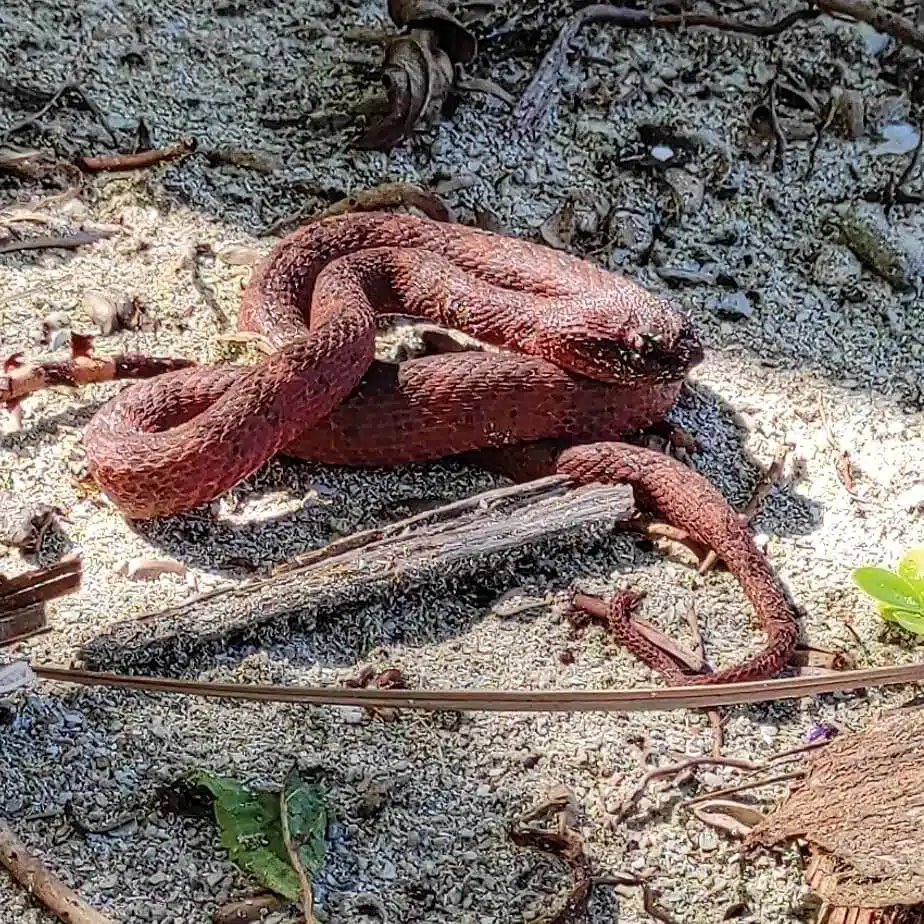
Scientific name: Bothriechis schlegelii.
Common name: eyelash viper.
The eyelash viper is a venomous pit viper, native to Central and South America. They are small and tree-dwelling vipers, known for their range of color variations.
These are small snakes with modified scales above their eyes, which look like the snake has eyelashes. The eyelashes assist in camouflage, breaking the snake’s outline in the foliage. They can be observed in reds, browns, pinks, and greens, and yellows, some are a combination of colors.
These snakes feed on small birds, rodents, lizards, and frogs. They are known to be aggressive and will bite if harassed. Even with the dangers, they are very popular in the exotic pet trade, captive-bred for their beautiful colors and patterns.
10. Southeastern Crown Snake
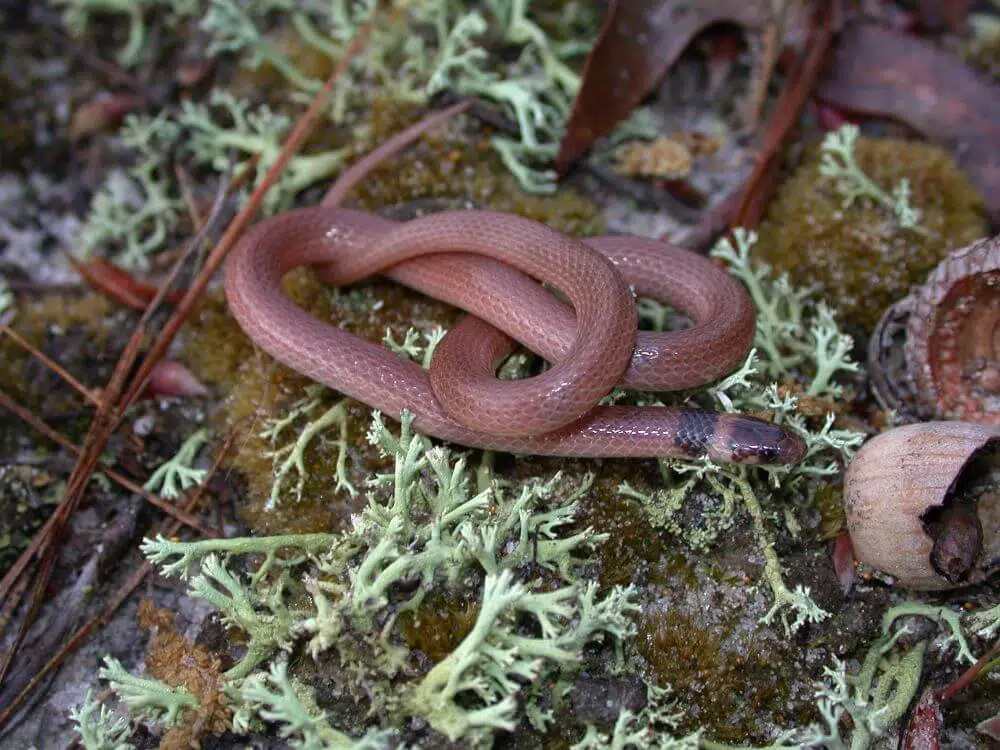
Scientific name: Tantilla coronata.
Common name: southeastern crown snake.
The southeastern crown snake is a small snake endemic to the southeastern United States. They are slender in build and range from a gray-brown to light brown with a black, pointed head and a yellow to cream band separating the neck and head. They have a black collar and the remainder of the body is red/brown.
The underside is usually a solid white or pink. These snakes grow to 25cm including their tails. They are more common in sandy or loose soil with plenty of organic litter. They can be found in dry and damp woodland habitats.
These snakes are active during the day and the warmer time of the year. They hide under leaf litter, logs, and rocks. They are excellent burrowers and swim in the sand in order to escape.
11. Florida Crowned Snake
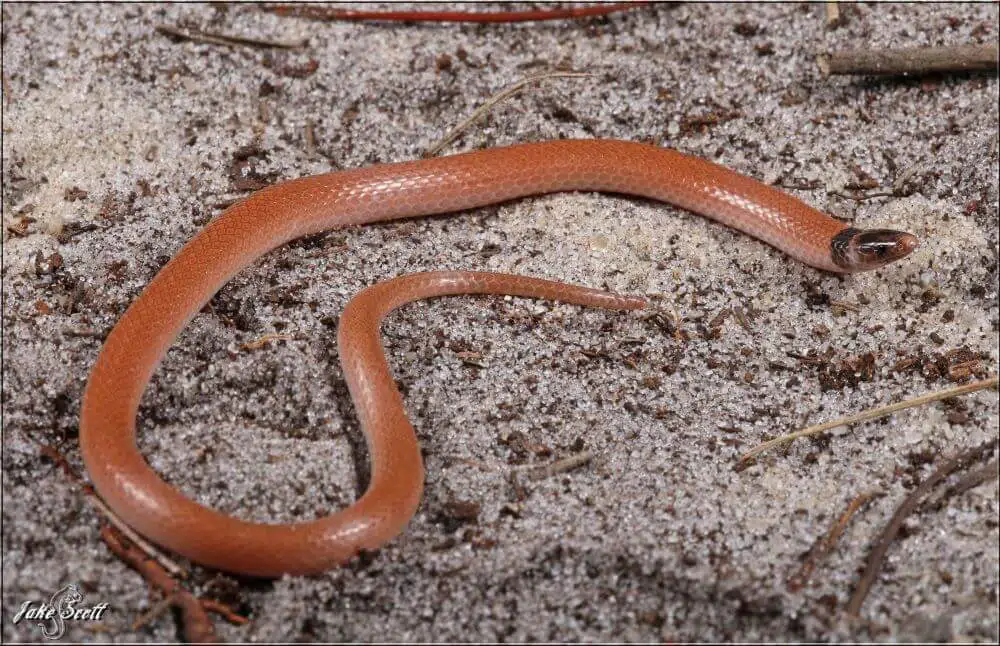
Scientific name: Tantilla relicta.
Common name: Florida crowned snake.
Florida crowned snakes are colubrid snakes, which are endemic to Florida, in the United States. They are slender, small, and non-venomous, which are not often observed. They are found in central and northern Florida, mostly seen in sandy habitats.
These snakes can grow to 22cm and are slender in size. They range from a tan to red/brown with a black to brown colored head. Some have a pattern on their heads, some also have a dark neckband or collar.
Their belly is a solid pink or white. They hide in burrows during winter and are mostly active in the warmer months. They are completely harmless to humans.
12. Northern Pacific rattlesnake
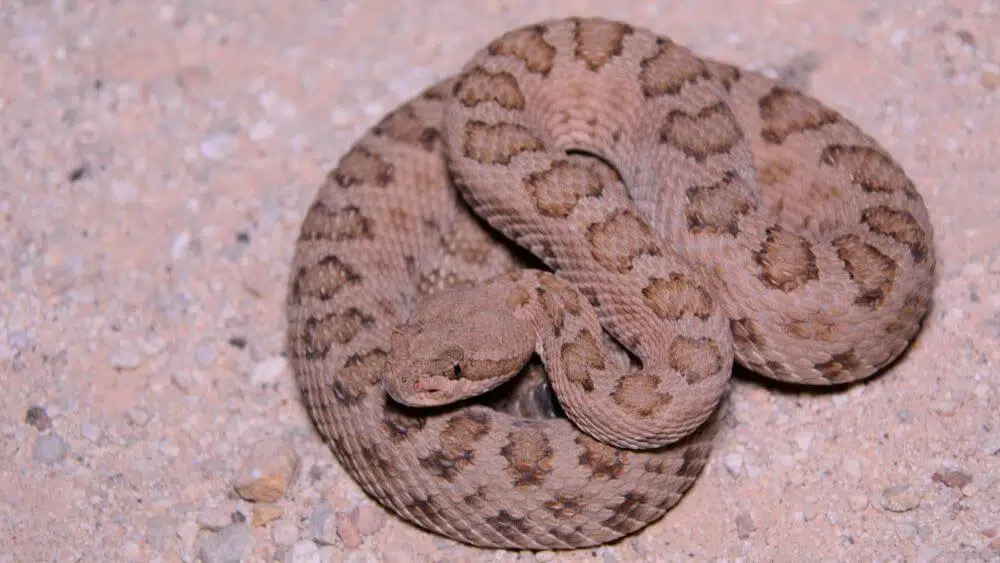
Scientific name: Crotalus oreganus.
Common name: Northern Pacific rattlesnake.
The Northern Pacific rattlesnake is a venomous pit viper found in western North America. They vary in size with mainland species growing to 100cm in length. They range in color and pattern. They usually match the ground color where they live.
Their colors range from tan and pink to gray, gold, or bronze. There is a pattern of dark blotches with uneven white edges on their backs which are wider in the center and narrower on the sides. The tail rings start as the same color as the blotches on its back and get darker as it gets near the tip.
They have a pale yellow belly with brown spots.
13. Sharptail Snake
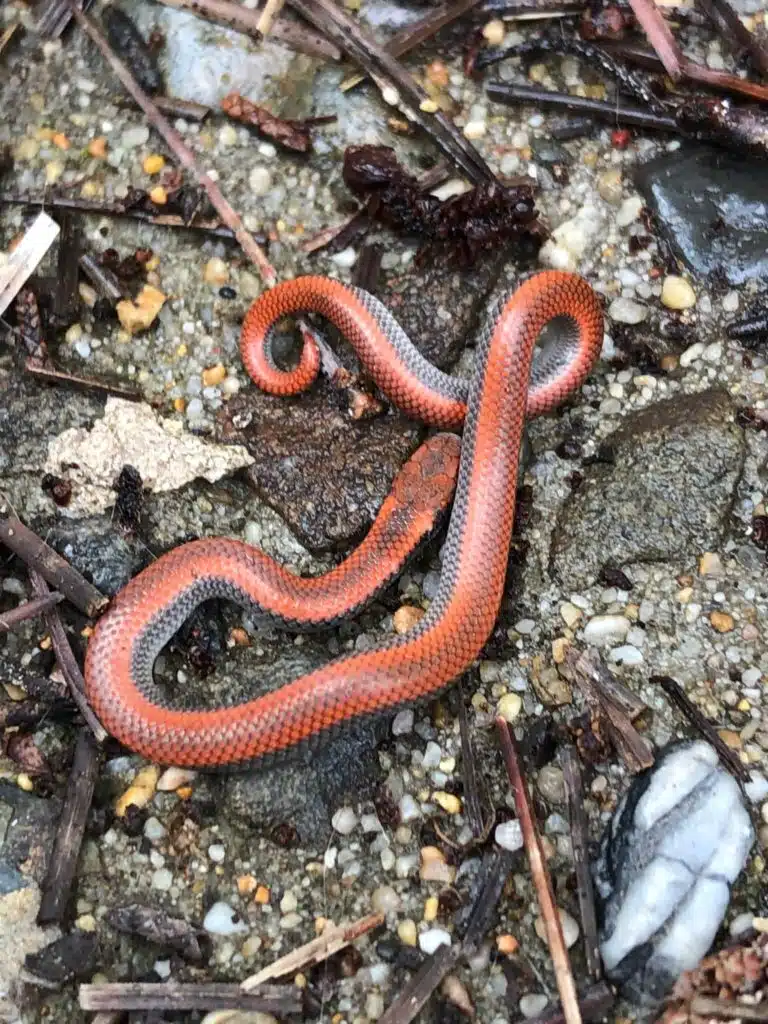
Scientific name: Contia tenuis.
Common name: sharp-tailed snake, sharptail snake.
Sharptail snakes are small snakes that grow to 46cm when adults. They have a sharp tail spine, which is completely harmless and cannot injure humans. The tail is used to stabilize prey.
They range from gray/brown to brick red with pink and peachy/orange specimens being observed. They have black and white crossbars on the belly. They are secretive and shy, usually found under rocks.
They burrow into soft soils, often encountered when digging in the garden.
14. Sidewinder
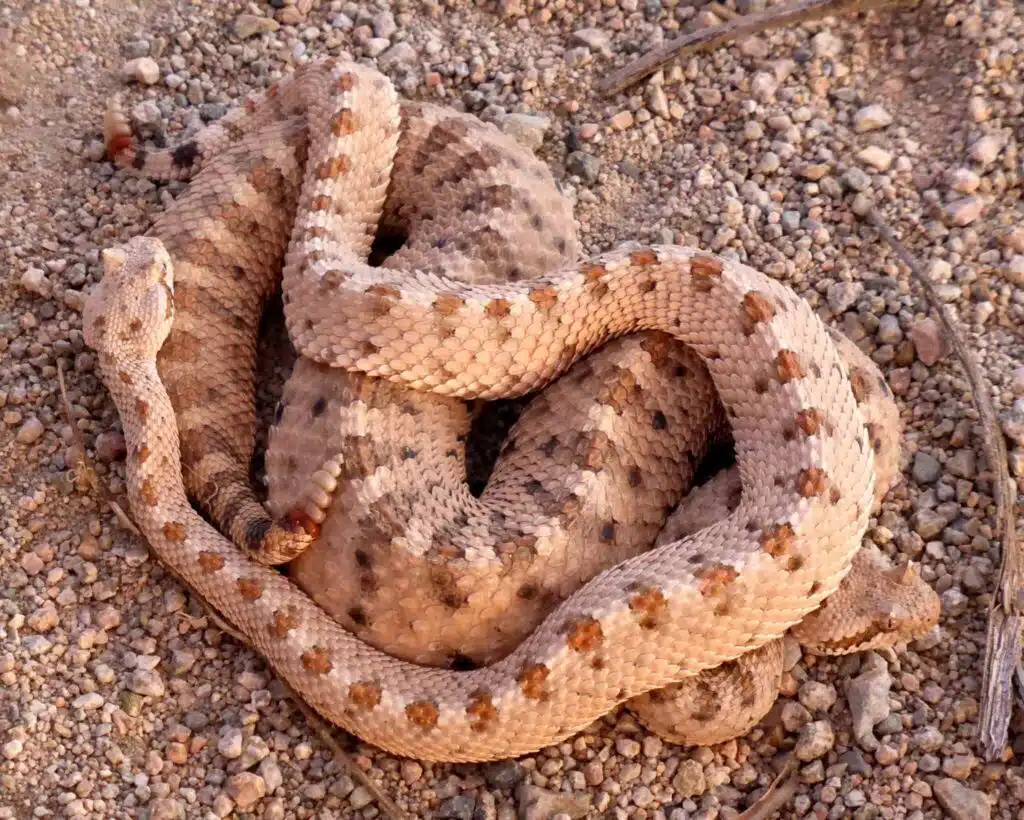
Scientific name: Crotalus cerastes.
Common name: sidewinder, horned rattlesnake, sidewinder rattlesnake.
Sidewinders are types of snakes of The Mojave Desert with a pink morph.
Bright brown or tan nuances with pink hues are specific to this desert snake that grows up to a size of just over 31 inches, at best.
A species that bears a resemblance to its arid climate, this is a species that also yields pink nuances at certain stages of its life.
It can be further distinguished by the lateral or side movements that help it advance quicker and which also inspired its name.
An actual rattlesnake, Sidewinders are venomous. These snakes might not be as venomous as other rattlesnakes in North America, but they can still be highly dangerous to humans and animals.
Its venom isn’t thoroughly studied as the species lives in remote areas of the desert where it never encounters humans.
People might not easily bump into Sidewinders as they prefer nocturnal feeding during the summer.
Not as long-living as other pink snakes, Sidewinders may still survive up to 13 years.
These types of snakes can be found in areas dominated by sand when not hibernating.
The species may not be spotted at all during its hibernation period. This is a long period when Sidewinders retreat into rodent burrows where they remain inactive.
15. Southwestern Speckled Rattlesnake
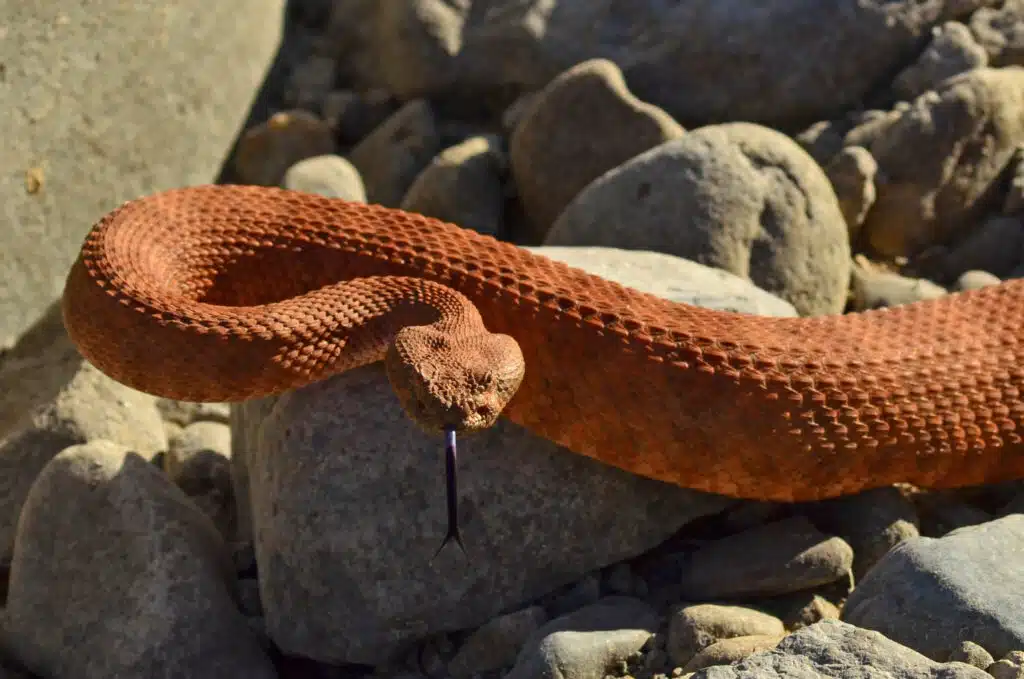
Scientific name: Crotalus Pyrrhus.
Common name: southwestern speckled rattlesnake, Mitchell’s rattlesnake.
Did you know the Southwestern Speckled Rattlesnake also comes in a pink morph?
Not many would associate rattlesnakes with pink nuances, but this is one of the common morphs of this North and Central American species.
While not as common as the brown or gray nuance morphs, the pink morph of the species has a bright nuance, covering its bright ground color and its brown marks.
The only part of the snake that isn’t pink in this morph is its rattle-like tip of the tail.
Also, pink, another morph of the species only shows bright pink base colors between its gray-bordered brown and black bands.
A species of hillsides, arid areas, and bottoms of canyons, Southwestern Speckled Rattlesnakes move into areas with rodents and small mammals which they eat.
16. Pink Snake
Scientific name: Cryptophis incredible.
Common name: Pink snake.
Pink Snakes are one of the least known species of snakes in Australia.
This species is found in different shades of pink. From bright pink to pink-red nuances, The Pink Snake is a small species believed to feed on lizards.
Pink Snakes are only found in Australia. Pink Snakes have only been confirmed outside mainland Australia on The Prince of Wales Island.
This remote area means the snake is a very rare sight. Some of its recent sightings include both bright pink and pink-red morphs.
By some theories, the snake may be brighter pink when found next to the beaches and darker when found further into the forests of the island.
17. Rose Big-tooth Snake
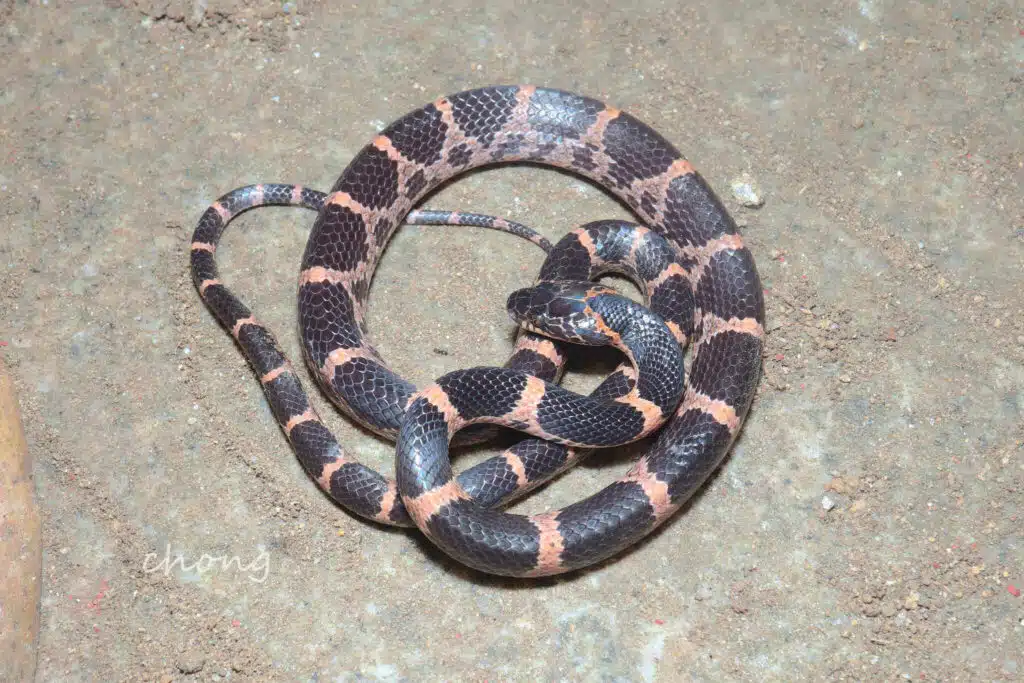
Scientific name: Lycodon Rosozonatus.
Common name: rose big-tooth snake, pink large-toothed snake.
An East Asian snake, The Rose Big-tooth Snake is among the multiple bicolored snakes that are also pink.
Very high color variation is specific to the species due to its vast range which expands from Vietnam to territories of Russia.
This species may typically appear black with pink bands and a pink underbelly.
Very bright pink nuances are specific to its dorsum, ventral side, and areas around its mouth.
Rose Big-tooth Snakes are also found in a couple of other morphs. This includes a black and orange morph as well as a black and tan morph.
Even the more common black and pink appearance of the species may vary, particularly for the pink nuances.
Growing up to a size of several feet, Rose Big-tooth Snakes are further known for their long fans and bright pink tongues.
18. Red-striped Smooth Snake
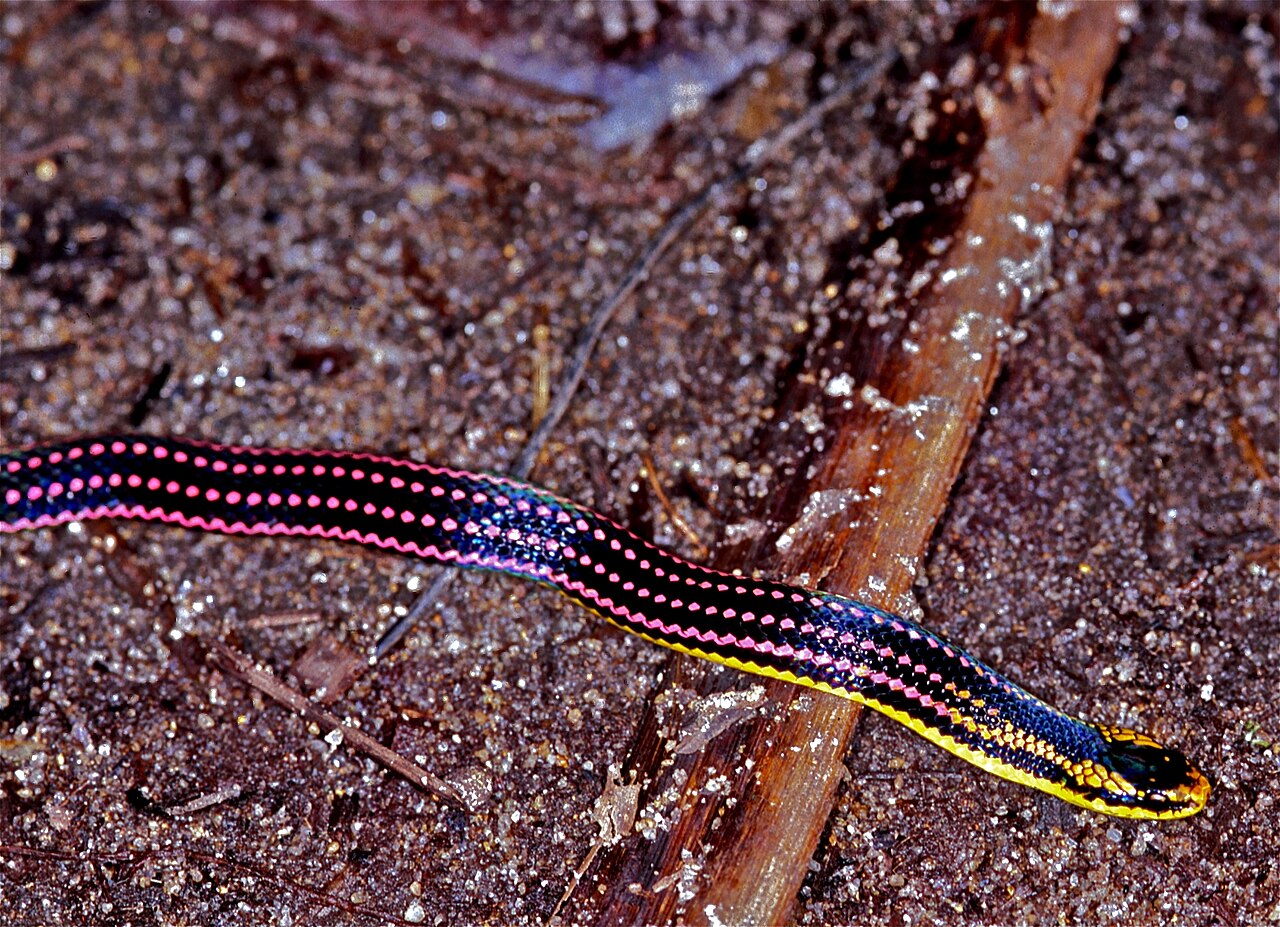
Scientific name: Liophidium Pattoni.
Common name: Red-striped Smooth Snake.
Only found in the forests of Madagascar, Red-striped Smooth snakes aren’t fully stripped.
These snakes are named after the rows of interrupted stripes across their black dorsum.
A colorful species, Red-striped Smooth snakes come in pink variants with the following pattern.
They show a black dorsum with rows of pink dots that run from the tip of the tail to its neck and which turn yellow on its head.
This common morph further shows vivid yellow underbellies with a bright pink tail.
Red interrupted stripes are still the dominant appearance of the species.
This morph shows white, red, and yellow dots arranged in rows or stripes along its dorsum.
All of these variants are found across Makira Natural Park.
19. Black-striped Snake
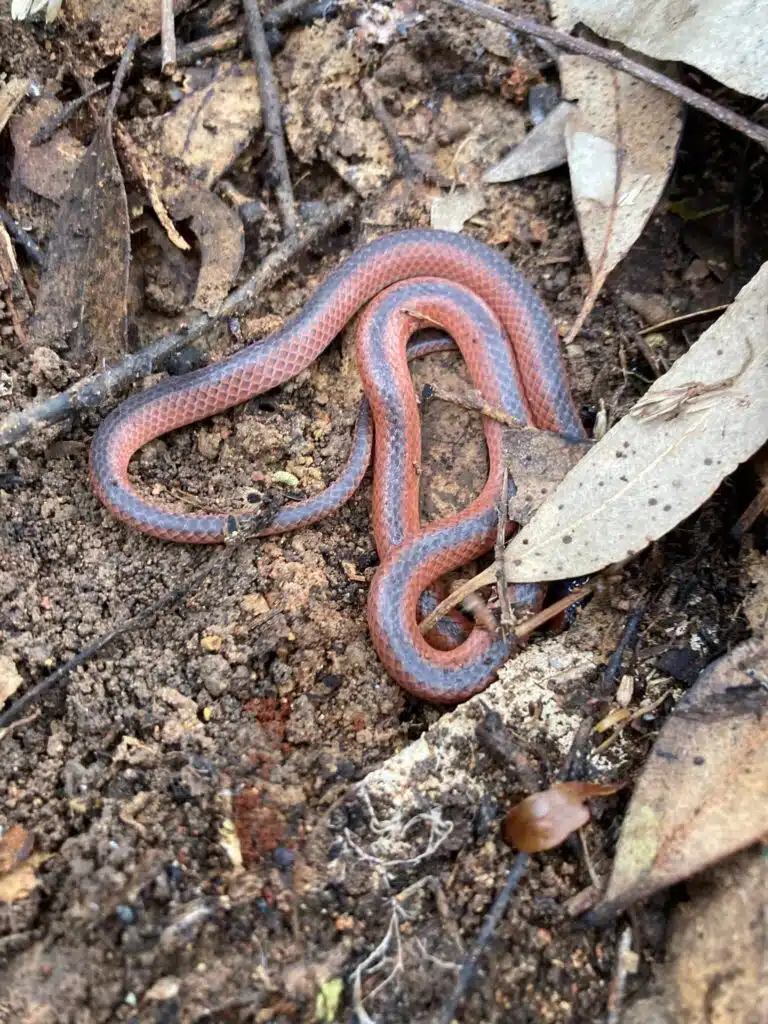
Scientific name: Cryptophis Nigrostriatal.
Common name: Black-striped Snake.
An Australian species also found in New Guinea, Black-striped Snakes show brown and pink nuances.
The pink sections of the species are limited to its underside as well as to its lower sides while brown nuances dominate its dorsum.
Some variants also exist. Most of its variants are either pink or red, with just a narrower mid-dorsum black stripe.
The snake may have a bright gray head, a dark gray head, or a black head, depending on its morph.
Other less common morphs don’t share any pink or red nuances at all.
These can be gray or brown morphs of various shades with a darker brown or a black mid-dorsal stripe.
20. Red Spitting Cobra
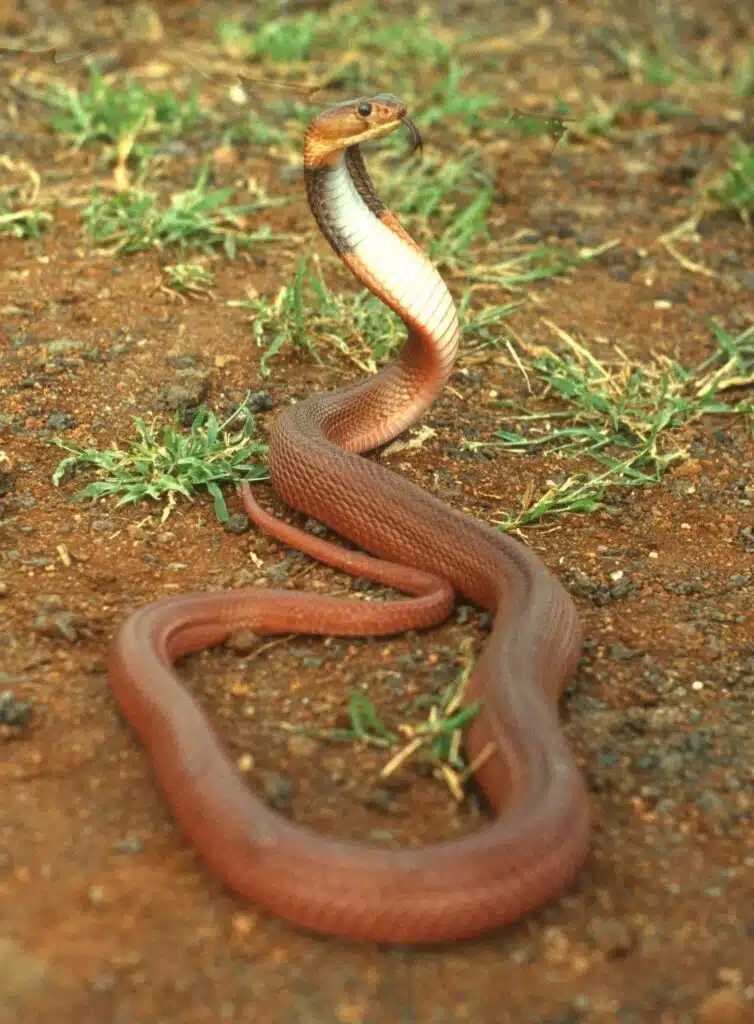
Scientific name: Naja Pallida.
Common name: Red Spitting Cobra.
Native to Africa, The Red Spitting Cobra is often pink. This is a snake found in multiple African countries with high color variation.
Some of the times when the cobra is particularly pink are in its juvenile days. This is when it shows dark pink nuances with wide black bands.
Even as an adult, this venomous snake can have bright pink underbellies and darker pink, red, or brown-red dorsal coloring.
A species that can raise its head when threatened, Red Spitting Cobras further show a distinguishing black band on its neck.
In its juvenile days, this snake shows white neck coloring.
The time of day this snake is spotted may also indicate its age.
Juveniles come out during the day while adults only come out at night.
A long-living species which can survive up to 20 years, The Red Spitting Cobra is one of the most dangerous pink snakes in the world. Its powerful venom can kill people or leave scars for life.
Summary
While you may not have expected pink to be a common color for snakes, there are numerous specimens that have pink coloration or a solid pink color. New species are also being observed, recorded, and studied, such as the blind pink snake, which was discovered in Madagascar in 2005.
Further Reading: